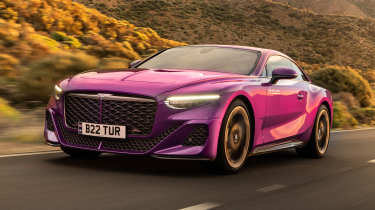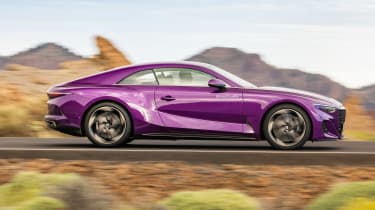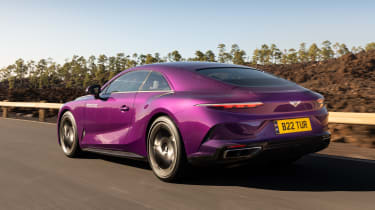New Bentley Batur 2023 review – can it possibly be worth £1.65m?
The Batur has been built as a 740bhp tribute to the W12 engine, with a hypercar price tag to match
Named after a crater lake on the island of Bali, the Batur is a re-bodied Continental GT Speed that follows on from the Bacalar, the one-of-twelve barchetta that if nothing else gave Bentley the increasing self-confidence to publicly undertake these more extreme projects.
Such endeavours fall under the remit of Bentley’s in-house coach builder Mulliner - the oldest such entity in the world - who offer, much like the exclusive operations of other high-end vehicle manufacturers, varying levels of ‘bespoke’, from unique colours through to complete cars. There will be 18 Baturs constructed, and yes, you guessed it, they’re already pre-sold: at this level a company has a very good idea who will buy such cars before the designer’s pen even touches the sketch pad.
Yet the Batur is more than just an ultra-exclusive Mulliner side project, it also heralds a new era for Bentley design that we’ll see on its forthcoming EVs. Moreover, it signifies the final flourish of the Bentley W12 engine after 20 years of being a motoring oddity that’s damn tricky to explain, and, if nothing else, it’s an interesting commentary on the world of the luxury performance car. All of which and more you might expect given it costs nearly ten times that of the car on which it’s based: a cool £1.65m plus local taxes.
More reviews
Group tests
- Alpine A290 v Alpine A110 – how much DNA do they really share?
- Ariel Atom 4R v Caterham Seven ‘evo25’: power-to-weight heroes go head-to-head
- Aston Martin Vantage vs Audi R8 V10 RWD – back to basics
- Caterham Super Seven 600 v Super Seven 2000
- Levante v T1
- Corvette Stingray v Porsche Cayman GTS v Audi R8 RWD
- Great Ferrari hypercars driven: 288 GTO, F40, F50 and Enzo head-to-head
- Lamborghini Aventador Ultimae v Lamborghini Countach
- Lotus Emira v Morgan Plus Four – four-cylinder Brits go head-to-head
- Toyota GR86 v BBR Mazda MX-5: supercharged drop-top battles sports coupe
In-depth reviews
- Abarth 600e 2025 review – Italy gives the Alpine A290 something to worry about
- Alpine A110 review – distinctive, lightweight and unforgettable to drive
- Audi RS7 Sportback Performance review
- Bentley Continental R Mulliner: review, history and specs
- BMW 5-series review – is this still Munich’s anchor model?
- BMW 1-series review – Munich’s Audi A3 rival gains focus
Long term tests
- Abarth 695C Turismo Fast Fleet test – 10,000 miles in the Italian hot hatch
- Alfa Romeo Giulia Veloce Fast Fleet test – 7000 miles in the sharp Italian saloon
- Alpina B10: end of term report
- Alpina B10
- Ford Mustang GT
- Ford Mustang GT
- Ford Mustang GT
- Land Rover Defender 110 Fast Fleet test – 9000 miles in the go-anywhere SUV
- Maserati Ghibli Trofeo Fast Fleet test – 4000 miles in the Ferrari-powered saloon
- Mitsubishi Evo MR 340
Review
- New Aston Martin DBS 770 Ultimate review – 759bhp super-GT driven
- 2023 Chevrolet Corvette C8 Z06 review – the American 911 GT3?
- Kia EV6 GT-Line S prototype review – the EV that shows how it’s done
- BBR Supercharged Mazda MX-5 (ND) 2023 review – tuned 250bhp roadster driven
- MG4 Trophy 2023 review
Reviews
- Abarth 695 75 Anniversario edition 2024 review – a fitting send-off for Abarth’s hot supermini?
- Abarth 500e 2023 review
- AC Cobra 378 Superblower MkIV 2021 review – another V8 Cobra, but with a GM heart this time
- Acura Integra Type S 2024 review – a Honda Civic Type R with added restraint
- Alfa Romeo Giulia 2025 review – get one while you still can
- Alfa Romeo SZ: history, review and specs of an icon
- Alfa Romeo 1750 TBi
- Alpina B3 GT Touring 2025 review – a 190mph alternative to the BMW M3 Touring
What of that design, then? There are three key elements to the new styling language: firstly, there’s the grille, which is mounted lower and is more upright than on the current cars. Then there’s what Bentley are calling the ‘endless bonnet’, which is a tangible line that runs from the grille, back down the flank, and culminates with a kick up behind the end of the side glass, the idea being to evoke the stately long noses of Bentleys past on cars with more modern packaging requirements. Finally, there’s the ‘resting beast stance’, which translates to the profile view as a car ready to respond but not overtly aggressively - think of the creases over the wheel arches as like a big cat haunches. Apparently.
I’ll let you make up your own mind on how the Batur looks; it certainly has impact sat purposefully on its 22-inch wheels, and to my eyes looks obviously ‘Bentley’, although perhaps that’s why it’s a little more ‘under the radar’ than other two million quid supercars.
The body is made from carbonfibre, which while bringing a small (proportionally) weight saving overall (40kg) is chiefly so that Bentley’s designers could craft a more sharply creased, detailed body than would be possible with a metal-suited vehicle that passes down the standard production line (just the windscreen and A-pillars are shared with the GT). There are no rear seats either, but the other major change involves the W12, which has been given a final evolution for the Batur with outputs rising from 650bhp/664lb ft in the Conti GT Speed, to 740bhp and a rippling 738lb ft of torque in the Batur. The surge in figures has been made possible thanks to modifications on the compressor side of the two turbochargers; a new air intake with 33% improved flow rate; deeper intercoolers with 35% greater capacity, and a unique calibration for the ecu. All together, they enable this to be the most powerful Bentley ever to leave Crewe.
Other than that, it’s very much a GT Speed, which is no bad thing, including the eight-speed twin-clutch gearbox, four-wheel drive setup, active anti-roll bars, three chamber air suspension, and so on. The track is slightly wider, and the engineers have taken the opportunity to have a brief play with the suspension settings, but any differences are minor.
The W12 fires up with its characteristic hearty ‘whumph’ that troubles window panes and suggests the kind of heavy transportation engineering that Crewe used to also be famous for may be about to leave the engine shed. Yet, if you’re in the standard ‘Bentley’ driving mode it quickly settles down and plays the role of the strong, silent type, smoothly whisking Batur occupants around with the kind of sumptuous excess surely desired by its well-heeled owners. Catch engine, gears and momentum just right and the engine has a wonderfully elastic relationship with the horizon, pottering one moment and then furiously snapping the view taught through the windscreen whatever the revs and speed with a form of relentless persuasion that’s almost impossible to resist.
Here’s a question though: does it feel as exciting as 740bhp sounds? I’m not sure - it’s amazing how 2.2 tons can ‘normalise’ such a colossal output, even with 738lb ft of torque doing the bidding, and there are occasions when the Batur can feel just a little sluggish, as if its caught off guard, and then the inertia comes into play, and there’s an uncomfortable pause before the sudden rush of torque begins, as if the gearbox is protecting itself first before dealing with the onslaught. The idea of twelve cylinders at this end of the market can’t help but sound wonderfully extravagant, but this is no twelve-pot with the sheer specialness of say, a Ferrari V12, and certainly not with the same kind of voice - and how many times have we written that about W12-engined cars over the years, closely followed by the inevitable ‘buy the lighter, more responsive, cheaper, twin-turbo V8 one’?
In most other respects the Batur is very good news. Bentley actively strive to make cars that mix everyday usability with long-legged luxury, and with a hearty dash of driver appeal mixed in for good measure. This is what you get with the Batur. It’s at its best when ‘making progress’, dismissing straights and normal traffic with long lunges of power and securely dispatching sweeping curves on the way to an exotic destination. It has doggedly admirable traction, while those hilariously large carbon-ceramic brakes - 410mm discs with 10-pot calipers on the front axle - have resilience and power that bely the forces they have to work against. Comfort is absolute behind the wheel; the ride wonderfully fluid in spite of those huge wheels, only tensing up if you’re in Sport mode, and overall NVH is reduced down to a minimum. With this level of serenity you could really knock back some miles in a day.
Push beyond a clean, seven-tenths approach, and inevitably the Batur is less content: the rear-wheel steering and active anti-roll bars can disguise the weight of the car to a very great extent, but try and throw it around on tighter, twistier routes, and it starts to feel a little ragged, and while it will slide at the rear, the drivetrain clunk as power is re-distributes suggests there are seismic forces being kept under control.
I enjoyed driving the Batur across some decent roads, but it’s patently obvious that you could have virtually the same experience in a GT Speed model. You’re not paying ten times the price to get essentially the same car that simply looks a little different: those 18 buyers have been enticed by firstly the exclusivity of the model, but also by the virtually limitless customisation options available. Each Batur buyer gets to have multiple spec sessions with a Mulliner designer, and can choose from a literally limitless palette of colours, and an even more baffling array of interior options, including plenty of sustainable materials, engravings, embossings, leathers, carbon fibre panels that morph colours and so on. Our car featured an intricate rotary control for the infotainment system that had been 3D printed and then covered in 18 carrot gold, while you can upgrade the hi-fi- system to the tune of, pun intended, £50k. All in, the average Batur has not left Crewe until £100,000 of options have been specified - in many ways the model is a blank canvas.
Bentley, much like Ferrari before them, and now every other high-end vehicle manufacturer, has sussed that the ticket to increasing revenue in a complex, crowded and cost-laden market is to maximise the take-up and profitability of the options list, and the Batur is gold dust in that regard. Perhaps, in some cases, literally. Bentley’s revenue increased by 9% in the first quarter of this year, with a significant improvement in its overall financial results, and part of that has been driven by customers spending more on personalisation and options for the mainstream models. Post Covid, the ‘haves’ are spending their money in more extroverted ways, and that’s good news for companies like Bentley - and for the gestation of models like the Batur.
| Engine | 6.0-litre twin-turbo W12 |
| Power |
740bhp @ 5500rpm |
| Torque | 738lb ft @ 1750-5000rpm |
| Weight |
2230kg (est) |
| 0-60mph | <3.3 secs |
| Top speed | 209mph |
| Price | £1.65m (plus tax) |








